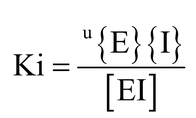Equilibrium constant for inhibitor binding is called Dissociation constant.
Enzymes of Class 11
Equilibrium constant for inhibitor binding is called Dissociation constant.
High Ki reduces enzyme activity, while low ki allows
 applicable to competitive inhibition.
applicable to competitive inhibition.
Proenzymes / Zymogens - Proenzyme is the inactive precursor of an enzyme. The term zymogen is often used for inactive precursor of proteolytic enzyme, e.g., pepsinogen for enzyme pepsin. Many enzymes are initially produced in the proenzyme or zymogen state. They become reactive or active enzymes only at a particular pH, in the presence of substrate or some special treatment. For example, pepsinogen is changed to active enzyme pepsin in the presence of hydrochloric acid of gastric juice. Thereafter, pepsin has autocatalytic effect on further conversion of pepsinogen.
Allozymes - Similar enzymes produced by different genes.
Constitutive enzymes - Enzymes which are always present because of their requirement for a vital process e.g. glycolysis.
Repressible enzymes - Normally present but are repressed when specific chemical or product is present e.g. glucokinase.
Inducible enzymes - Formed in response to its substrate e.g. lactase.
Immobilisation of Enzymes-It is attaching or trapping enzymes in inert supporting materials (calcium alginate beads) for better efficiency and recovering them after the reaction. Sometimes the cells producing the enzymes are immobilised e.g. yeast cells. Immobilised enzymes are protected from proteases remain pure and easily extractable can be used continuously for long time.
- Introduction of Enzyme
- Properties of Enzymes
- Nomenclatures of Enzymes
- Chemical Nature of Enzymes
- Mechanism of Enzyme Action
- Factors affecting the Rate of Enzyme
- Enzyme Inhibition
- Equilibrium constant for inhibitor binding is called Dissociation constant.
- Economic Importance of Enzymes
- Exercise 1
- Exercise 2
- Exercise 3
- Exercise 4
- Exercise 5









